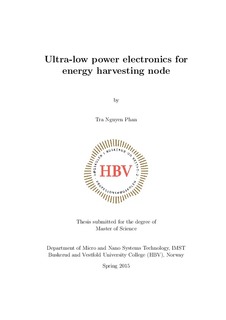| dc.description.abstract | There face challenges to build power management circuit for microscale electrostatic vibration energy harvesting. Small capacitance variation limited by standard fabrication process is a common obstacle to obtain sufficient transduction for power conversion. The electronic circuit encounters an issue of compatibility to MEMS integration based on available techniques. A key function of the built interface circuit is able to drive and to power the whole system with only power extracted from ambient vibration. Thus, the energy harvesting system becomes completely autonomous without using any extra suppliers or biases.
This work is to build an ASIC interface circuit for the MEMS electrostatic energy harvester where range of transducer capacitance is below∼10 pF. The designed circuit is therefore proper for typical comb-drive overlapping capacitive transducers. The circuit topology consists of three main elements: double charge pump, flyback path and controlling switch. Among them, the switch plays an extremely important role to control the harvesting system. Optimization of switching sequence has significant effect on harvested power from electrostatic transducer. A control circuit is proposed to detect moments and then to turn on/off switch optimally. As a result, the designed circuit is automatic to control the switch during vibration cycles. To be the selfsustaining system, the circuit draws obtained energy stored in reservoir capacitor to power the entire interface circuit. With the current topology including clocking, a net energy of 7.97 nJ is achieved during 1 second when capacitance variation of the transducer has Cmin = 2.156pF and Cmax = 8.624 pF.
Alternatively, a voltage-quadrupler circuit topology is designed to be adaptive to the comb-drive overlapping capacitive transducers. A major advantage of this self-sustaining configuration is that by integration of transducer to series-connected rectifier-capacitor combination, output voltage is boosted to infinite value in principle. For example, with an initial voltage 3 V applied for transducer with nominal capacitance of 30 pF, the obtained voltage ramps up to about 14 V after only 40 ms. | nb_NO |
